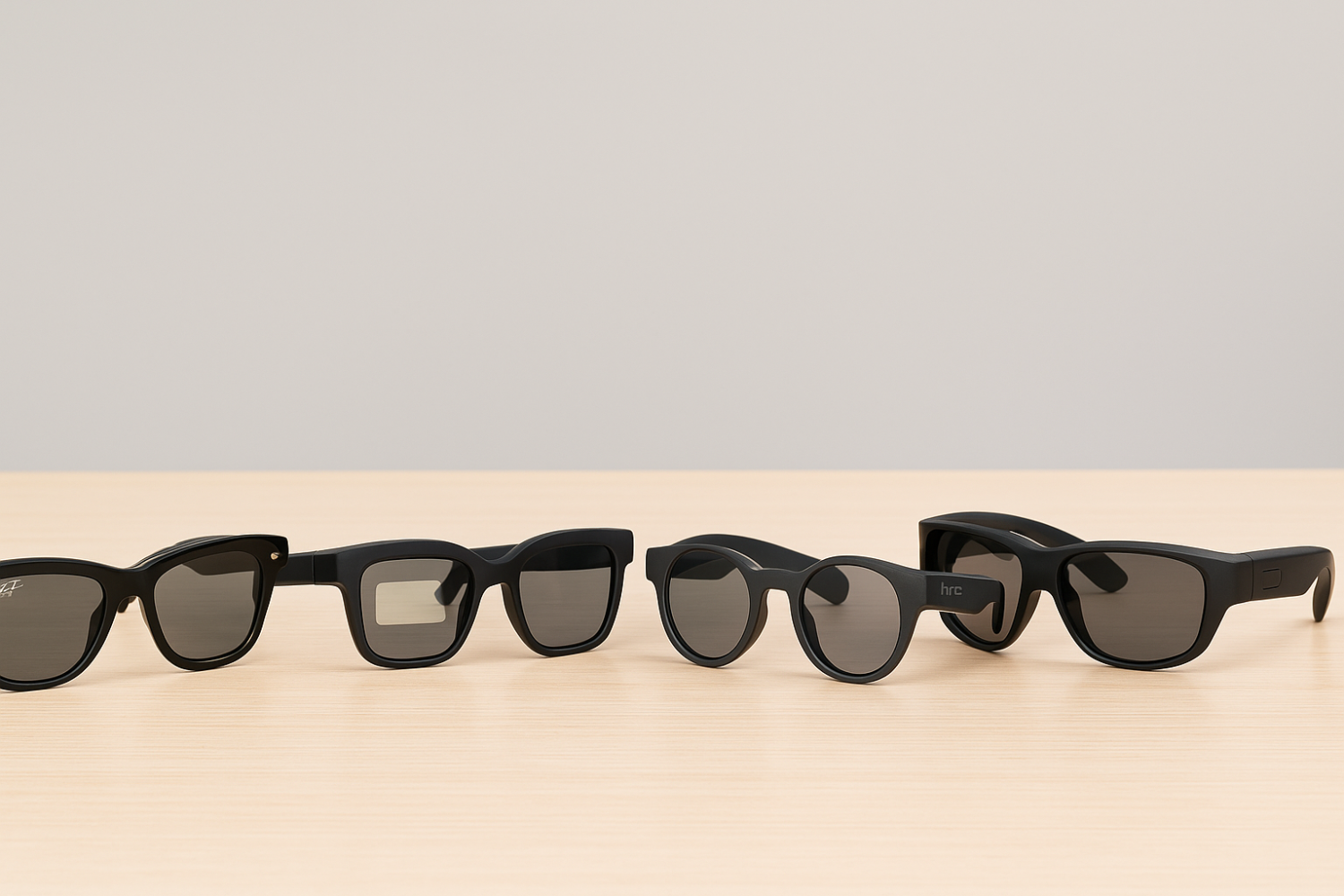In the early 2010s, “AI smart glasses” were mostly a Silicon Valley experiment — a blend of innovation, hype, and awkward design. Google Glass became a meme before it became a movement, and for nearly a decade, the idea of wearing a computer on your face was written off as too weird to survive.
But in 2025, the narrative has flipped. AI has changed the game. The new generation of smart glasses doesn’t just record what you see — they understand it, describe it, translate it, and react in real time. From Meta’s Ray-Ban collaboration to upstart challengers like Rokid and HTC, the “AI wearable” category is finally taking shape.
This isn’t science fiction anymore. It’s fashion, utility, and artificial intelligence merging in front of our eyes.
The Players Defining the Smart Glasses Race
Meta x Ray-Ban are leading the mainstream charge. Their second-generation Ray-Ban Meta smart glasses, developed with EssilorLuxottica, combine everyday style with on-device AI features like real-time translation, scene description, and voice assistance. Over-the-air updates continue to add new tools, including generative AI responses and live streaming to Instagram and Facebook.
Meta’s next leap — the Ray-Ban Display — includes a transparent lens-based AR system that shows information overlays without turning your glasses into a bulky headset. Think: a whisper of text, not a sci-fi visor.
HTC is entering the field with the Vive Eagle, a lightweight pair (under 50 grams) that prioritizes translation and real-time object recognition through a 12MP ultrawide camera. Meanwhile, Rokid, a Chinese startup, has been pushing compact projection technology and eye-safe displays that blend entertainment and productivity in one portable platform.
Apple and Google are rumored to be working on next-gen models for 2026, with Apple’s “Project Iris” drawing comparisons to Vision Pro — except pocketable. Until then, Meta, Rokid, and HTC are running the show.
What Makes Smart Glasses AI Smart
To qualify as “AI smart glasses,” it’s not enough to have a camera and Bluetooth. The key is intelligence that interacts with context.
Here’s what defines this new class of devices:
Computer Vision: The glasses can “see” — identifying people, objects, and places around you, then responding naturally.
Generative AI: Instead of static answers, you get conversational, creative, or descriptive output. “What am I looking at?” can return “That’s a Tesla Model 3 in matte gray — want to learn about its specs?”
Real-Time Translation: Text and speech translations appear seamlessly, letting you navigate foreign cities hands-free.
Voice-First Experience: Spoken commands like “record that,” “describe what’s ahead,” or “summarize this scene” turn your daily life into an interactive dialogue.
Edge Compute + Low Latency: Tiny neural chips process data locally to reduce lag, protect privacy, and extend battery life.
The result? Glasses that feel more like an AI assistant you wear — not a camera you carry.
Meta’s Ray-Ban Revolution
Meta’s Ray-Ban smart glasses have become the face of this movement — literally. What started as an accessory for social creators is evolving into a wearable assistant that blends fashion and function.
What’s working:
- Mass Appeal: They look like normal sunglasses — not like you’re wearing a computer.
- Constant Upgrades: Meta’s AI model gets smarter every month, now capable of identifying landmarks, pets, products, and text in multiple languages.
- Hands-Free Streaming: Influencers, creators, and journalists can go live directly from their glasses to social platforms.
- Better Audio and Cameras: Directional microphones and improved image stabilization make it usable even in motion.
The pain points:
- Battery life still struggles past 3–4 hours.
- Privacy concerns linger — especially in public spaces.
- AR display versions face visibility and brightness challenges.
- Not every model supports prescription lenses.
Even so, Meta’s blend of hype, fashion, and AI has brought smart glasses closer to mainstream adoption than any company before it.
This isn’t another Google Glass moment. The timing finally makes sense.
AI Models Can See. Vision-language models like GPT-4o and Gemini handle real-world interpretation in real time.
Chips Are Smarter. Low-power AI processors enable offline recognition without constant cloud calls.
Display Tech Evolved. Microprojectors and waveguides make see-through lenses usable in daylight.
Cultural Acceptance. After years of Siri, Alexa, and ChatGPT, people are used to talking to machines.
Style Matters Again. Meta partnered with Ray-Ban and Oakley — not a robotics lab.
We’ve crossed from can it be done to does it look good enough to wear?
What People Actually Use Them For
The promise of AI eyewear isn’t just hype. Real-world use cases are beginning to surface across consumer and professional spaces:
Live Translation & Travel: Tourists in Tokyo can see English subtitles appear next to Japanese signs.
Accessibility: For blind or low-vision users, AI can narrate surroundings out loud.
On-the-Go Recording: Journalists and creators can document moments without holding a camera.
Workplace Guidance: Technicians or medics can get live overlays and remote instructions.
Social Streaming: TikTok, Instagram, and YouTube integration make POV content effortless.
Personal Memory Bank: Capture photos, locations, or snippets of your day without even touching your phone.
It’s a shift from device to experience — one that turns your field of view into an interactive feed.
The Design Tightrope
Creating usable AI glasses means balancing beauty, battery, and brains:
- Too heavy? No one will wear them.
- Too bulky? They look ridiculous.
- Too weak? They’re just fancy Bluetooth headphones.
Meta’s Ray-Ban Display reportedly hits the sweet spot with less than 55 grams of weight, a small AR overlay, and neural-band gesture control via subtle wrist movements. Meanwhile, companies like Rokid are experimenting with modular battery packs and transparent OLED lenses.
The holy grail is invisible technology — something you forget you’re even wearing.
The Real-World Risks
AI-powered eyewear brings the same ethical questions that have followed facial recognition, smartphones, and AR since day one:
- Privacy: Cameras on your face are unsettling, no matter how small the LED indicator is.
- Bias: Vision models still misinterpret darker skin tones or complex environments.
- Data Security: Cloud-linked devices risk streaming sensitive visuals.
- Social Norms: Will restaurants, schools, or workplaces ban smart glasses outright?
- Information Overload: Constant overlays could blur the line between focus and distraction.
For the tech to survive, it’ll need as much cultural engineering as code.
What’s Coming Next
2025 through 2026 will be a make-or-break moment for the entire category.
Display Glasses Go Mainstream: Meta’s Ray-Ban Display launches this fall with real-time captions and GPS overlays.
Apple’s Entry Looms: A potential “Apple Vision Glass” could debut in 2026.
Cheaper Models Hit Shelves: Expect $199–$299 AI glasses from startups within the year.
Gesture Controls Improve: EMG-based wristbands and eye tracking will replace voice-only input.
Enterprise Use Explodes: AI overlays will guide fieldwork, inspections, and inventory faster than tablets ever could. If 2024 was the warm-up, 2025–2026 is the sprint — and Meta is already leading the race.
The Verdict: Between Novelty and Necessity
AI smart glasses are no longer a Silicon Valley sideshow. They’re a proving ground for what happens when hardware, software, and self-expression collide.
Meta’s Ray-Ban line has given the space credibility. HTC and Rokid are showing that smaller brands can innovate faster.
Apple’s silence only raises anticipation.
And with AI models now capable of true multimodal perception — sight, sound, and context — the foundation for a wearable revolution is set.
Still, we’re early.
These devices have to prove they’re more than a flex.
The difference between a fad and a future will depend on whether these AI smart glasses can become as natural as putting on a pair of shades before walking out the door.
For now, the world’s biggest companies are betting billions that your next screen won’t be in your hand — it’ll be on your face.







